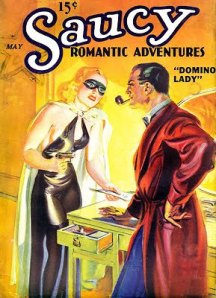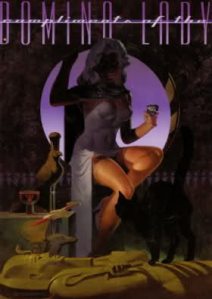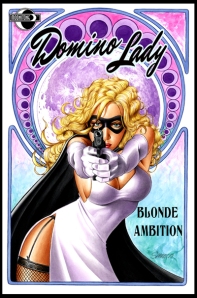Even for softporn it’s pretty tame stuff:
“A nightgown of sheerest, green silk was but scant concealment for her gorgeous figure. A chastely-rounded body and a slender waist served to accentuate the seductive softness of her hips and sloping contours of her slim thighs, while skin like the bloom on a peach glowed rosily in the reflected sunlight.”
Or better still:
“With a feeling of naughtiness, she slipped into a pair of black-lace panties. Then, sheerest hose for her shapely legs, black velvet slippers for the dainty feet.”
It’s 1936, and we’re flipping through the pulp-grade pages of Saucy Romantic Adventures. Our heroine, a lady thief and proto-Batman, is Ellen Patrick, AKA The Domino Lady. She’s going to punish those crooked politicians who murdered her father. Which apparently will require a great deal of bathing and napping and dressing and undressing, but no descriptions of genitalia, primary or secondary. The closest we get to a sex scene is:
“An hour later, Ellen left Raythorne’s cabin.”
Five stories appear in Saucy, and a sixth in the still milder Mystery Adventure Magazine. It’s a short run, even by pulp standards, all credited to Lars Anderson, an untraceable pseudonym. Ron Wilber resurrected the scantily-clad avenger for Eros Comix in the mid-90s, and Moonstone Books published a collection of new short stories and a comic book by Nancy Holder and Steve Bryant. Silver Age icon Jim Steranko also illustrated a collection of the original stories, plus a seventh of his own, “Aroused, the Domino Lady.” Jim is a saucier than Lars:
“Only the tops of Ellen’s thighs were covered by the kimono. When she spun and kicked it was shockingly apparent that she wore no underwear and that her flesh was the color of pale alabaster in the secret slopes and valleys above her tanned legs.”
“Domino,” by the way, is a description of Ellen’s mask (the style sported by Robin and the Lone Ranger) not “dominatrix,” the S&M term appropriated from Latin in the sixties. Ellen is no dominator. She’s more likely to get herself into a compromising corner. Though, despite all that sloping and peach-blooming sensuality, she doesn’t end up getting much.
The Domino Lady is one of the very few Depression-era superheroines, debuting the same year as the Phantom, Ka-Zar, and the Green Hornet. Though not as virginal as Doc Savage and Clark Kent, she has less in common with 1930s Mystery Men who share their batcaves with “fiancés” or 1940s comic book superheroes with their ambiguous “wards.”
Ellen is a loner. She likes foreplay, but always escapes before the climax. Where most of her male predecessors settled into their marriage plots, the Domino Lady rejects such happiness: “the amorous little adventuress had denied the love she craved with all her heart. To her affection and marriage were things to avoid, shun.” Like Batman, Ellen’s Daddy-avenging mission is all that gets her off.
It also helps not to have a recurring love interest. No Lois Lane is trying to peek under her mask and/or kimono every month. And no Margo Lane is cooking her breakfast. Ellen may spend an hour in Mr. Raythorne’s cabin, but she climbs into bed alone at the end of her adventures. Raythone is just a one-story fling, ignorant of her secret identity. A month later the Domino Lady is saving another equally eligible bachelor from certain death, relieved afterwards when the so-called detective remains clueless. “Ellen Patrick laughed throatily as she went to his open arms.” Only the reader is in on the joke. No one else ever sees her naked.
Her thrills, like the reader’s, are vicarious. She specializes in stealing “compromising letters” from blackmailers, the plot engine of half her tales. The “indiscrete” content is never spoken, just Ellen’s promise: “that precious husband of yours will never find out.” She likes secrets. She never reveals her own and she never reveals any of the friends’ she saves. It makes her an accessory after the fact, each adventure a retroactive ménage a trios.
Plus there’s the thrill of the adventure itself. In fact, forget Daddy. What really gets Ellen going is the danger, the threat of being caught and unmasked: “Her heart was thumping with the acceleration of the chase, the knowledge that here was new, exciting adventure in the making! It was her life, her greatest thrill of living!”
If unmasking is the deepest intimacy, a forced unmasking is rape. Anderson has Ellen flirt with that fantasized danger every issue. Her adversaries arouse her. One blackmailer “was the type who could stir her soul to the depths and arouse the latent passions of her affectionate nature.” When cornered for the first time in her career, her mask about to be torn away, “Ellen was thrilling as she had never thrilled before.” And if that orgasm metaphor is too subtle for you: “Something totally primitive had awakened in her innermost being, she thrilled to the core!”
But these are fantasies under Ellen’s control. Anderson’s action sequences always turn on the Domino Lady’s ability to remain “cool as a cucumber,” “cool as winter breeze.” Unlike Zorro’s self-arousing costume, the Domino Lady protects Ellen from herself: “hot blood in her veins turned to a gelid stream of ice as Ellen stared through the mask.”
Her other lovers are her biggest threat, men who could make her surrender herself, give in to the affection she’s “starved” for. Ellen may love a “gaze penetrating to the very center of her being,” but it’s her own “hungry longings” she battles. The men are interchangeable, not the “compelling desire” she holds out against. Winning for the Domino Lady means no happy endings.
The fifth story concludes both her vengeance plot and her run in Saucy. Those dastardly politicians are brought to ruin for murdering her father. But a month later, Anderson reboots in Mystery Adventure, and those vague and omnipresent villains are still at large. A superhero’s mission is never ending. Even a softporn superheroine never climaxes.
Good girls don’t unmask. It’s a bizarrely sexualized celibacy plot. In the end Ellen climbs into bed alone again, still anticipating the romance she defers, still only “vaguely cognizant of the emptiness of her lonely existence.” She’s still Daddy’s girl after all.



Ever read Spicy Detective Stories ?
In fact there’s a whole slew of soft-porn ‘Spicy’ titles, with even some comics in the back of the mag:
https://www.google.com/search?hl=fr&site=imghp&tbm=isch&source=hp&biw=1280&bih=913&q=spicy+detective+covers&oq=spicy+detectiv&gs_l=img.1.1.0j0i30l3.2056.7701.0.10304.14.9.0.5.5.0.87.483.9.9.0.msedr…0…1ac.1.64.img..0.14.488.8LlG1ZeIH0s#hl=fr&tbm=isch&q=spicy+detective+comics
Yeah, I’m a dirty old man.
It’s those back page comics that I’m particularly interested, especially since the Spicy line was published by Donenfeld, future publisher of DC. I would love to read a collection of Olga Messmer stories, but I don’t think they’ve ever been reprinted. She’s superstrong and even has Superman’s X-ray vision, but she premieres a year before Action Comics No. 1.
Interesting – the daddy worship is repeated in CAT’S EYE, an anime series following three female art thiefs.
Sadly, villainous protagonists are totally abscent in todays stories. I wonder what it was that made this kind of stories thrive in certain decades?
Some older books, like HER DARK INHERIANCE (1892), holds up, while others are just outdated. How well does DOMINO LADY fare – is it worth a read?
I wouldn’t actually call it good, Kasper, but I do enjoy analyzing it. But remove the analytical lens, and it’s pretty dreadful stuff. Entertainingly dreadful.
Pingback: 10apr2015 | Aditya B.'s Blog About Things